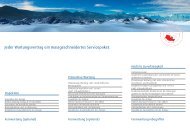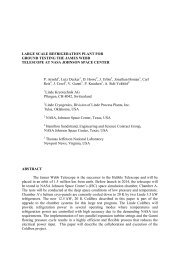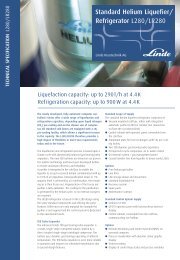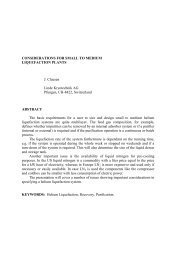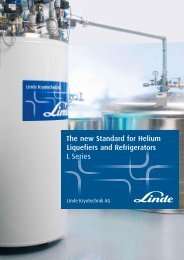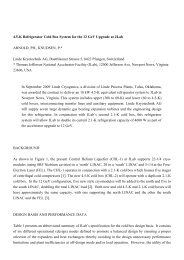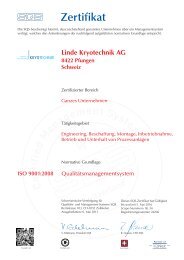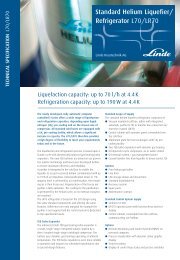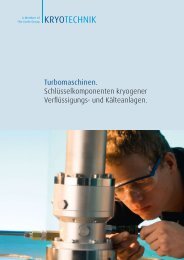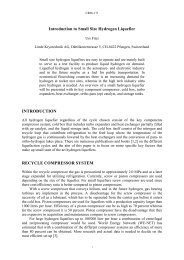Efficiency of Hydrogen Liquefaction Plants - Linde Kryotechnik AG
Efficiency of Hydrogen Liquefaction Plants - Linde Kryotechnik AG
Efficiency of Hydrogen Liquefaction Plants - Linde Kryotechnik AG
Create successful ePaper yourself
Turn your PDF publications into a flip-book with our unique Google optimized e-Paper software.
<strong>Efficiency</strong> <strong>of</strong> <strong>Hydrogen</strong> <strong>Liquefaction</strong> <strong>Plants</strong><br />
Takashi FUKANO**, Urs FITZI*, Karl LÖHLEIN*, Isabelle VIN<strong>AG</strong>E*<br />
* <strong>Linde</strong> <strong>Kryotechnik</strong> <strong>AG</strong>, CH-8422 Pfungen, Switzerland<br />
** Nippon Sanso Corporation, JP-210-0861 Kawasaki-City, Japan<br />
Abstract<br />
A medium scale hydrogen liquefaction plant is presented and its efficiency analyzed on the<br />
basis <strong>of</strong> exergy.<br />
In a first step, the operating principal <strong>of</strong> a medium scale hydrogen liquefier is presented. The<br />
liquefaction plant consists <strong>of</strong> a compressor system and a vacuum insulated cold box where the<br />
liquefaction takes place. In the cold box, the refrigeration capacity required to liquefy the<br />
hydrogen is provided by a hydrogen refrigerant cycle and a liquid nitrogen pre-cooling step.<br />
The cooling capacity is extracted from high pressure hydrogen through oil bearing turbines<br />
and cooling takes place in aluminum plate fin heat exchangers.<br />
Secondly, an extensive exergy analysis <strong>of</strong> the liquefaction process considering the exergy<br />
losses <strong>of</strong> each step will be presented. The exergy losses in hydrogen liquefaction are caused<br />
within the liquefier itself, for example in the compressor system or the turbines, but also occur<br />
during filling procedure <strong>of</strong> the liquid hydrogen in trailers, or distribution <strong>of</strong> the liquefied<br />
hydrogen. Within this paper the efficiency <strong>of</strong> the liquefaction process from gaseous hydrogen<br />
supply to the delivery <strong>of</strong> liquid hydrogen into the storage tank will be discussed.<br />
Keywords: liquefier, exergy, efficiency, o-p-conversion<br />
Introduction<br />
The medium size hydrogen liquefier described consists <strong>of</strong> a compressor system using piston<br />
compressors with three pressure levels and a liquefier cold box containing the liquid nitrogen<br />
precooling unit and the hydrogen cooling cycle with expansion turbines. Table 1 shows the<br />
main parameters characterizing the system.<br />
Table 1: Main plant data<br />
<strong>Liquefaction</strong> capacity l/h 3'000<br />
Electric power input kW 1'555<br />
Liquid nitrogen consumption l/h 2'475<br />
Product pressure MPa 0.15<br />
Product temperature K 21.68<br />
Para-content % > 95<br />
Figure 1 shows a simplified flow sheet <strong>of</strong> the liquefier system. It consists <strong>of</strong> the hydrogen feed<br />
stream, which enters the cold box at approx. 2 MPa and is continuously converted from ortho<br />
to para hydrogen whilst it is cool-down using the catalyst directly placed in the heat<br />
exchangers. Between heat exchanger 7 and 8 it is throttled to tank pressure within a device<br />
called "ejector" functioning similar to a water jet blast sucking displaced or flash gas from the<br />
tank being re-liquefied in heat exchanger 8.<br />
1
Refrigeration down to 80 K is provided by using a nitrogen precooler: liquid nitrogen is<br />
throttled into a phase separator flooding heat exchanger 2 with liquid and by so cooling the<br />
feed stream to approximately 81 K. Evaporated nitrogen is warmed up to ambient in heat<br />
exchanger 1 pre-cooling the feed stream in countercurrent flow.<br />
Refrigeration from 80 K to approximately 30 K is carried out using a so-called Brayton cycle:<br />
high pressure hydrogen <strong>of</strong> about 2 MPa is expanded in three turboexpanders switched in<br />
series to medium pressure and warmed up to ambient providing refrigeration.<br />
From 30 K to liquefaction a so-called Joule-Thomson cycle is applied consisting <strong>of</strong> heat<br />
exchangers 7, 8, and a throttle valve at the bottom, where the high pressure gas is throttled to<br />
low pressure providing the lowest temperature <strong>of</strong> the system. After warming up this gas is<br />
compressed in the first stage compressor to medium pressure and reunified with the return gas<br />
from the expanders, sucked by the high stage compressor.<br />
Feed<br />
GN2<br />
LN2<br />
HE 1<br />
HE 2<br />
HE 3<br />
HE 4<br />
HE 5<br />
HE 6<br />
from trailer front end<br />
from storage<br />
to storage<br />
HE 7<br />
HE 8<br />
Figure 1: Flow sheet <strong>of</strong> the liquefier system<br />
2
System Analysis<br />
The easiest approach to a thermodynamic analysis <strong>of</strong> a system is to introduce exergy as<br />
additional information for each state point. Exergy, the maximal available work, is defined as<br />
or integrated<br />
de = dh - T 0 ds (1)<br />
e 1 = h 1 - h 0 - T 0 (s 1 - s 0 ) (2)<br />
where e 1 is the maximum work, that can be obtained from a periodic process between state 1<br />
and ambient condition 0.<br />
T<br />
Feed<br />
310 K<br />
HP MP LP HX<br />
N2 H2 H2<br />
1<br />
2<br />
3<br />
4<br />
5<br />
6<br />
7<br />
21.7 K<br />
8<br />
s<br />
Figure 2: T-s diagram <strong>of</strong> the liquefaction process<br />
For the whole system as well as for parts <strong>of</strong> it, thermodynamic efficiencies can be calculated<br />
as ratios <strong>of</strong> minimum exergy necessary to exergy actually applied. For a system analysis,<br />
however, it is more reasonable to calculate the exergy loss occurring in a component and to<br />
compare it to the exergy input to the system.<br />
For the hydrogen liquefier considered, exergy flow diagrams were plotted showing the exergy<br />
losses and the exergy finally supplied to the tank as a percentage <strong>of</strong> the exergy input into the<br />
system which equals the electric power input to the electric motor <strong>of</strong> the compressors plus the<br />
exergy contained in the liquid nitrogen and feed flow supplied.<br />
Heat leaks into the liquefier are not taken into account.<br />
3
total el.<br />
power<br />
input<br />
100<br />
(71.9)<br />
(part <strong>of</strong><br />
total<br />
exergy input)<br />
62.6 to coldbox<br />
(45.0)<br />
3.6<br />
electric<br />
motors<br />
27.9<br />
compressors<br />
5.9<br />
gas<br />
coolers<br />
Figure 3: Exergy flow diagram <strong>of</strong> the compressor system<br />
Figure 3 shows the exergy flow diagram <strong>of</strong> the compressor system. The power input into the<br />
electric motor drives <strong>of</strong> the compressors is only part <strong>of</strong> the exergy input to the liquefier. The<br />
percentage <strong>of</strong> the total exergy input is therefore given in brackets.<br />
A large amount <strong>of</strong> the exergy is dissipated in<br />
the electric motors<br />
the compressors and<br />
the gas coolers.<br />
Finally 62.6 % <strong>of</strong> the exergy input is passed onto the liquefier cold box.<br />
The exergy losses in the cold box are due to inefficiencies <strong>of</strong> turbines, valves, heat<br />
exchangers, and the process itself.<br />
Turbines: In an ideal turbine the exergy change <strong>of</strong> the fluid expanded equals the mechanical<br />
energy extracted. In a real turbine the following irreversibilities have to be considered:<br />
1. The turbine extracts only part <strong>of</strong> the energy it ideally could.<br />
2. The mechanical power extracted is dissipated in a brake cycle.<br />
Figure 4 shows, that the lower the operating temperature <strong>of</strong> the turbine, the smaller the part <strong>of</strong><br />
exergy loss in the brake compared to the total loss.<br />
4
Exergy Loss [kW]<br />
90<br />
80<br />
70<br />
60<br />
50<br />
40<br />
30<br />
20<br />
10<br />
0<br />
1 2 3<br />
Turbine No.<br />
due to dissipation <strong>of</strong> the power extracted<br />
due to turbine inefficiency<br />
Figure 4: Exergy loss <strong>of</strong> the turbines<br />
Heat exchangers: The exergy losses in the heat exchangers amount to 21.6 % <strong>of</strong> the exergy<br />
input to the plant. The losses are caused by<br />
non-ideal heat transfer 3.7 %<br />
pressure drop 2.8 %<br />
process design 15.1 %<br />
The figures show, that major part <strong>of</strong> the losses are due to process design and would occur<br />
even using ideal heat exchangers.<br />
Valves: There are only three throttling valves within the plant causing a small loss, namely<br />
the Joule-Thomson valve in the cooling cycle, the ejector in the feed flow and the throttling<br />
valve for liquid nitrogen.<br />
recycle<br />
compressors<br />
45.0<br />
39.7 liquid to tank<br />
73.1<br />
liquid nitrogen 17.6<br />
compressed<br />
feed gas<br />
10.5<br />
21.6<br />
heat exchangers<br />
9.3<br />
turbines<br />
2.5<br />
valves<br />
Figure 5: Exergy flow diagram <strong>of</strong> the coldbox<br />
5
Figure 5 shows the exergy flow diagram <strong>of</strong> the liquefier itself. From the 73.1 % entering the<br />
box at the cold end there are 39.7 % left as the product flow.<br />
Conclusion<br />
The calculation <strong>of</strong> exergy losses is a very powerful means to identify sources <strong>of</strong><br />
irreversibilities, their portion <strong>of</strong> the total loss, the potential for improvement and to determine<br />
their effect on power input and operating costs <strong>of</strong> the plant.<br />
Notation<br />
e exergy J/g<br />
h enthalpy J/g<br />
s entropy J/g K<br />
T temperature K<br />
Indices<br />
0 ambient (293.15 K, 0.1013 MPa)<br />
1 general state point<br />
References<br />
[1] K. Löhlein and T. Fukano: Exergy Analysis <strong>of</strong> Refrigerators for Large Scale Cooling<br />
Systems, Fusion Engineering and Design, Vol. 198, North Holland Physics Publishing,<br />
1992.<br />
[2] James E. West: The Economics <strong>of</strong> Small to Medium Liquid <strong>Hydrogen</strong> Facilities. Cryogas<br />
International, May 2003.<br />
[3] Hans Quack: Die Schlüsselrolle der <strong>Kryotechnik</strong> in der Wasserst<strong>of</strong>f-Energiewirtschaft.<br />
Wissenschaftliche Zeitschrift der Technischen Universität Dresden, 50 (2001) Heft 5/6.<br />
6



